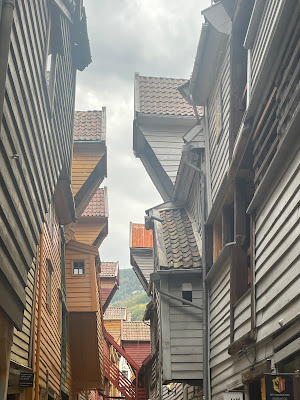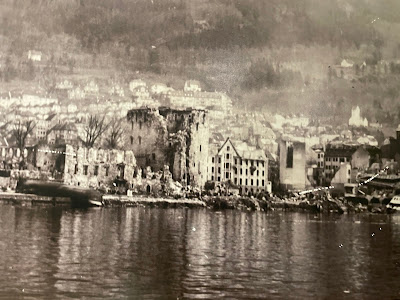Today we woke up to rain, but it was never a downpour and we managed not to get very wet.
After another hearty breakfast at the hotel, we went to the Burgen Fortress and overdosed on history! The fortress dates to the 1200s under King Magnus the Lawmender. The part we explored is called Rosencrantz Tower, named after a Dutch governor when Norway was under Dutch rule. (1560 was when Erik Rosencrantz was governor; he added onto the Tower.)
While it has been damaged over the years, much of the Tower is original, including Magnus's bed chamber and chapel.
 |
| View from the tower of our hotel |
The stairs in the tower are circular, stone and narrow with rope railings. We were reminded of how much our children loved exploring castles when they were young; all children would have loved today's itinerary. At 74, we went up and down very carefully!
The biggest battle that involved the fortress was the Battle of Vagen in 1665 when it was the Dutch versus the British. The Dutch East India Company had a convoy from Indonesia laden with great treasure. Due to storms, the fleet went into Bergen's harbor. There were spices, ebony, silk, rubies, diamonds, and pearls on board 10 of the 60 ships in the fleet. They decided to wait for warships to escort them home. It is estimated that it was worth more than a year's worth of the entire revenue of the Danish crown. (So, the Danish really wanted it!)
 |
| In the original chapel |
The British attacked first, but were unable to get into the harbor. But, they fired upon the fort and the town. A cannonball is visible in the cathedral in Bergen all these centuries later. The Dutch ships showed up several days later and it was not worthwhile for the British to attack again. Thus, they did not succeed in grabbing the treasure. However, the town and the fort were significantly damaged.
 |
| Narrow and winding ancient stairs |
 |
| Replica of tombstone of Erik Rosenkrantz and his wife. |
After exploring the Tower, we went to Hakon's Hall, also from the time when Bergen was Norway's capital. It was built as a royal residence by King Hakon Hakonsson between 1267-1261. Hakon was the father of King Magnus the Lawmender.
What is left from the time is a large banquet hall. Again, it has been largely reconstructed. It is Norway's largest building from the Medieval Era. The impressive hall's ceiling looks like the bottom of a Viking ship.
 |
| Hakon's Hall. Note the ceiling that looks like the bottom of a ship |
A tapestry which goes the length of one of the walls is a replica of calendars used at the time. The Norwegian year began in April and ended in March, and was divided into sections by religious events (saints' days mostly).
 |
| A section of the tapestry |
From there, we went to the third site of our day - a museum mostly devoted to the time period of the Norwegian resistance against the Nazis in World War II. It was an interesting and heart-breaking museum. Norway fell to the Germans in 1940, so was occupied right up to the end of the war.
 |
| Part of the medieval part of Bergen; headquarters of the Hanseatic League |
Bergen was a major port for submarines and considered vital to the Germans. Russian prisoners of war, virtual slaves, provided much of the labor in Bergen. Norwegians in public positions had to be members of the Nazi Party of Norway under the rule of the Nazi collaborator, Viktun Quisling who was executed after the war for high treason and murder.
 |
| A ship exploded (by accident) during World War II and did extensive damage to the town and Fort. At the time, sabotage was suspected. |
The museum told harrowing and brutal stories of the round-up of the Resistance and the local Jews (there were not many in Bergen). Some Norwegian men who escaped Norway were trained as soldiers in Scotland and called the Whalers. They often fared better than those in the Resistance. Many of those in the Resistance were discovered and sent to concentration camps.
After all that history, spanning eight centuries, we went to a local bakery for skillingbolle, a cinnamon bun that is famous in Burgen. (It was recommended by our former student, Danica Buckley and we just had to get one.)
Then - back to the exercise room and sauna before another hearty dinner.






No comments:
Post a Comment
Note: Only a member of this blog may post a comment.